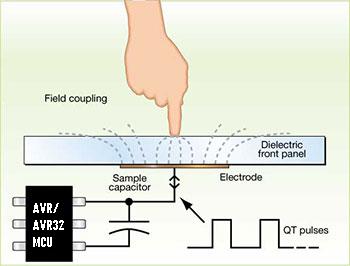The QTouch acquisition method charges an electrode of unknown capacitance to a known potential. The resulting charge is transferred into a measurement capacitor (Cs). The cycle is repeated until the voltage across Cs reaches a voltage Vih. The signal level is the number of charge transfer cycles it took to reach that voltage. Placing a finger on the touch surface introduces external capacitance that increases the amount of charge transferred each cycle, reducing the total number of cycles required for Cs to reach the voltage. When the signal level (number of cycles) goes below the present threshold, then the sensor is reported to be in detected.
QTouch acquisition method sensors can drive single or multiple keys. Where multiple keys are used, each key can be set for an individual sensitivity level. Keys of different sizes and shapes can be used to meet both functional and aesthetic requirements.
NOTE: It is recommended to keep the size of the keys larger than 6mmx6mm to ensure reliable and robust measurements, although actual key design requirements also depend on panel thickness and material. Refer to the ATMEL Capacitive touch sensor design guide for details.
QTouch acquisition method can be used in two ways
- 1.
normal touch contact (i.e. when pressing buttons on a panel), and
- 2.
high sensitivity proximity mode (i.e. when a panel lights up before you actually contact it).

QTouch circuits offers high signal-to-noise ratio, very good low power performance, and the easiest sensor layout.